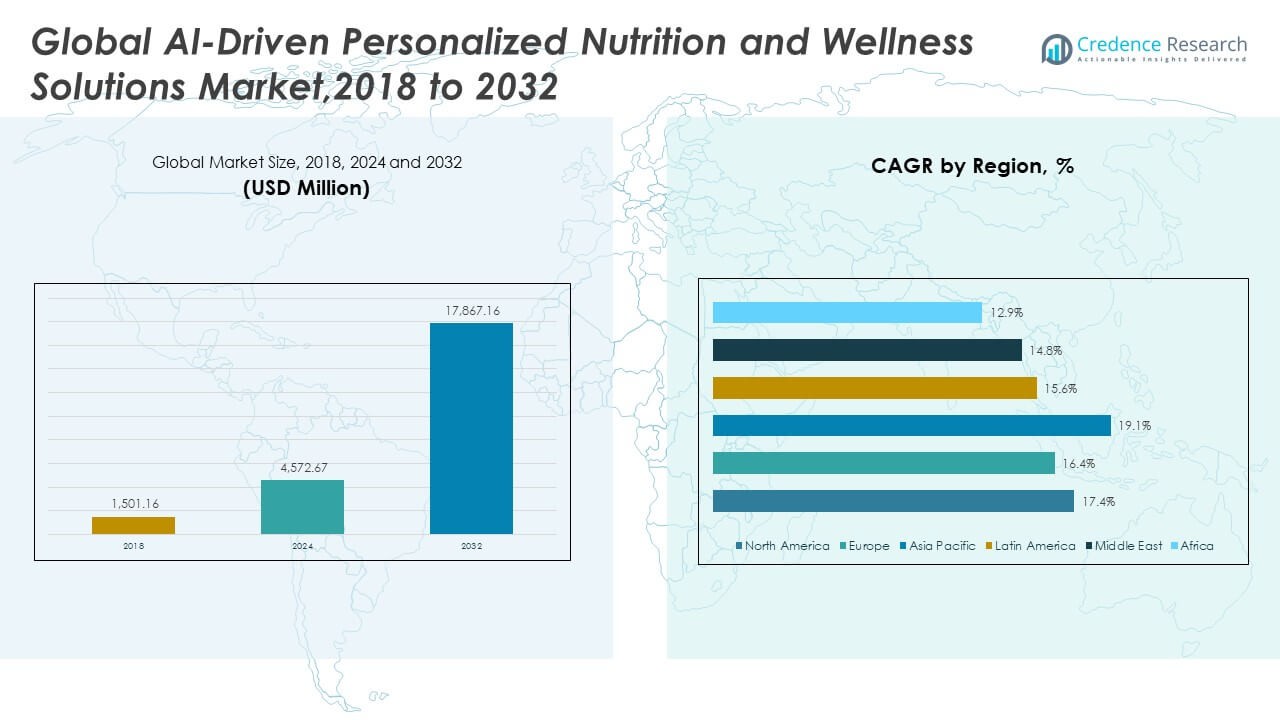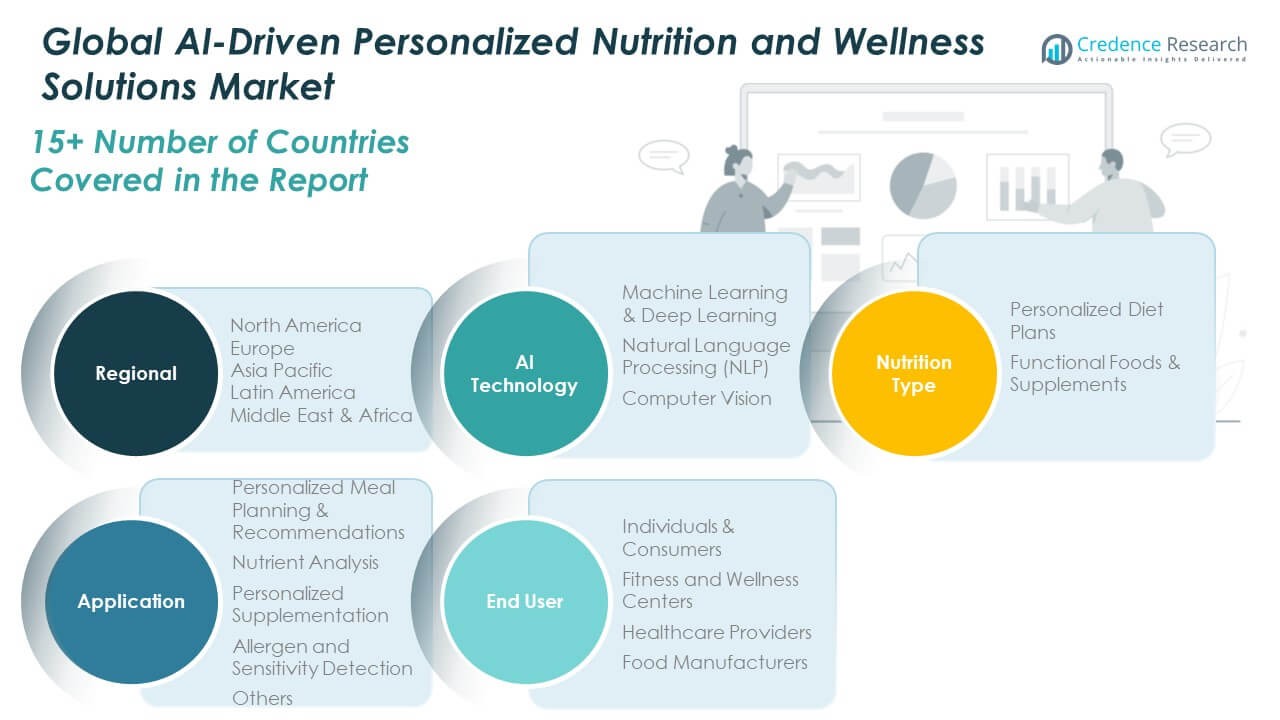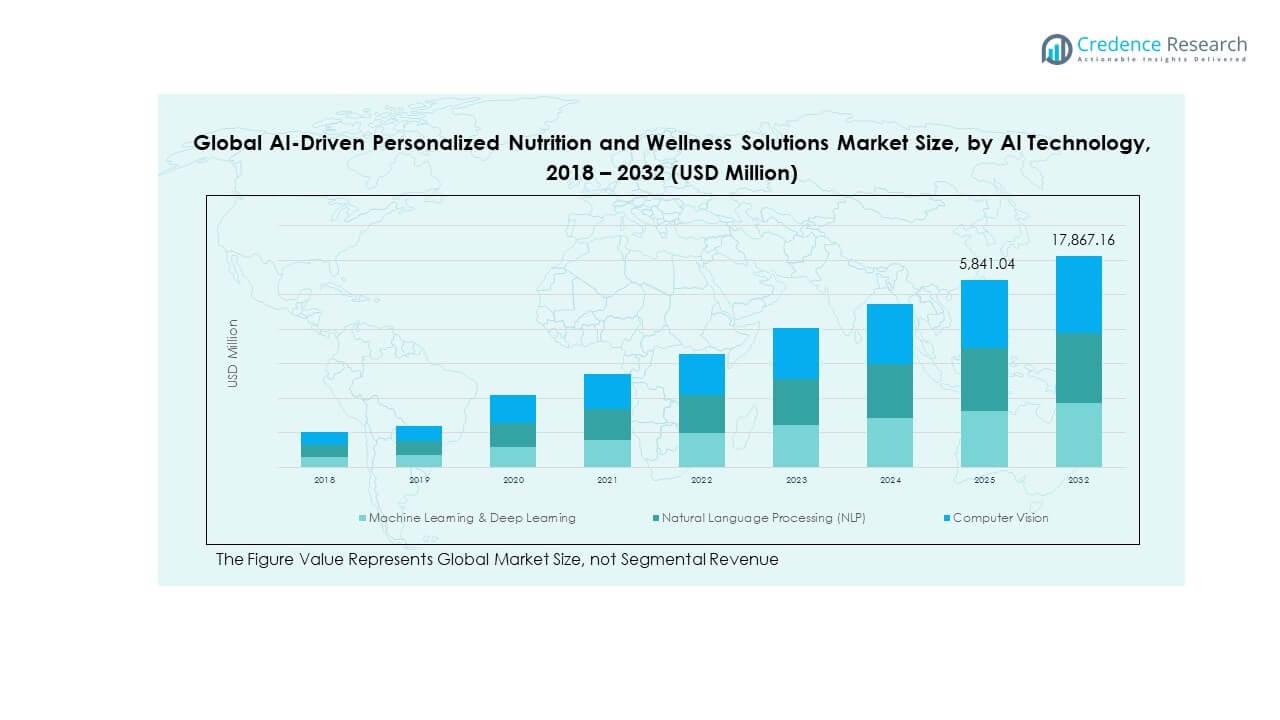CHAPTER NO. 1: GENESIS OF THE MARKET
1.1 Market Prelude – Introduction & Scope
1.2 The Big Picture – Objectives & Vision
1.3 Strategic Edge – Unique Value Proposition
1.4 Stakeholder Compass – Key Beneficiaries
CHAPTER NO. 2: EXECUTIVE LENS
2.1 Pulse of the Industry – Market Snapshot
2.2 Growth Arc – Revenue Projections (USD Million)
2.3. Premium Insights – Based on Primary Interviews
CHAPTER NO. 3: AI-DRIVEN PERSONALIZED NUTRITION AND WELLNESS SOLUTIONS MARKET FORCES & INDUSTRY PULSE
3.1 Foundations of Change – Market Overview
3.2 Catalysts of Expansion – Key Market Drivers
3.2.1 Momentum Boosters – Growth Triggers
3.2.2 Innovation Fuel – Disruptive Technologies
3.3 Headwinds & Crosswinds – Market Restraints
3.3.1 Regulatory Tides – Compliance Challenges
3.3.2 Economic Frictions – Inflationary Pressures
3.4 Untapped Horizons – Growth Potential & Opportunities
3.5 Strategic Navigation – Industry Frameworks
3.5.1 Market Equilibrium – Porter’s Five Forces
3.5.2 Ecosystem Dynamics – Value Chain Analysis
3.5.3 Macro Forces – PESTEL Breakdown
3.6 Price Trend Analysis
3.6.1 Regional Price Trend
3.6.2 Price Trend by Product
CHAPTER NO. 4: KEY INVESTMENT EPICENTER
4.1 Regional Goldmines – High-Growth Geographies
4.2 Product Frontiers – Lucrative Product Categories
4.3 Application Sweet Spots – Emerging Demand Segments
CHAPTER NO. 5: REVENUE TRAJECTORY & WEALTH MAPPING
5.1 Momentum Metrics – Forecast & Growth Curves
5.2 Regional Revenue Footprint – Market Share Insights
5.3 Segmental Wealth Flow – AI Technology & Application Revenue
CHAPTER NO. 6: TRADE & COMMERCE ANALYSIS
6.1. Import Analysis by Region
6.1.1. Global AI-Driven Personalized Nutrition and Wellness Solutions Market Import Revenue By Region
6.2. Export Analysis by Region
6.2.1. Global AI-Driven Personalized Nutrition and Wellness Solutions Market Export Revenue By Region
CHAPTER NO. 7: COMPETITION ANALYSIS
7.1. Company Market Share Analysis
7.1.1. Global AI-Driven Personalized Nutrition and Wellness Solutions Market: Company Market Share
7.2. Global AI-Driven Personalized Nutrition and Wellness Solutions Market Company Revenue Market Share
7.3. Strategic Developments
7.3.1. Acquisitions & Mergers
7.3.2. New Product Launch
7.3.3. Regional Expansion
7.4. Competitive Dashboard
7.5. Company Assessment Metrics, 2024
CHAPTER NO. 8: AI-DRIVEN PERSONALIZED NUTRITION AND WELLNESS SOLUTIONS MARKET – BY AI TECHNOLOGY SEGMENT ANALYSIS
8.1. AI-Driven Personalized Nutrition and Wellness Solutions Market Overview by AI Technology Segment
8.1.1. AI-Driven Personalized Nutrition and Wellness Solutions Market Revenue Share By AI Technology
8.2. Machine Learning & Deep Learning
8.3. Natural Language Processing (NLP)
8.4. Computer Vision
CHAPTER NO. 9: AI-DRIVEN PERSONALIZED NUTRITION AND WELLNESS SOLUTIONS MARKET – BY NUTRITION TYPE SEGMENT ANALYSIS
9.1. AI-Driven Personalized Nutrition and Wellness Solutions Market Overview by Nutrition Type Segment
9.1.1. AI-Driven Personalized Nutrition and Wellness Solutions Market Revenue Share By Nutrition Type
9.2. Personalized Diet Plans
9.3. Functional Foods & Supplements
CHAPTER NO. 10: AI-DRIVEN PERSONALIZED NUTRITION AND WELLNESS SOLUTIONS MARKET – BY APPLICATION SEGMENT ANALYSIS
10.1. AI-Driven Personalized Nutrition and Wellness Solutions Market Overview by Application Segment
10.1.1. AI-Driven Personalized Nutrition and Wellness Solutions Market Revenue Share By Application
10.2. Personalized Meal Planning & Recommendations
10.3. Nutrient Analysis
10.4. Personalized Supplementation
10.5. Allergen and Sensitivity Detection
10.6. Others
CHAPTER NO. 11: AI-DRIVEN PERSONALIZED NUTRITION AND WELLNESS SOLUTIONS MARKET – BY END USER SEGMENT ANALYSIS
11.1. AI-Driven Personalized Nutrition and Wellness Solutions Market Overview by End User Segment
11.1.1. AI-Driven Personalized Nutrition and Wellness Solutions Market Revenue Share By End User
11.2. Individuals & Consumers
11.3. Fitness and Wellness Centers
11.4. Healthcare Providers
11.5. Food Manufacturers
CHAPTER NO. 12: AI-DRIVEN PERSONALIZED NUTRITION AND WELLNESS SOLUTIONS MARKET – REGIONAL ANALYSIS
12.1. AI-Driven Personalized Nutrition and Wellness Solutions Market Overview by Region Segment
12.1.1. Global AI-Driven Personalized Nutrition and Wellness Solutions Market Revenue Share By Region
12.1.2. Region
12.1.3. Global AI-Driven Personalized Nutrition and Wellness Solutions Market Revenue By Region
12.1.4. AI Technology
12.1.5. Global AI-Driven Personalized Nutrition and Wellness Solutions Market Revenue By AI Technology
12.1.6. Nutrition Type
12.1.7. Global AI-Driven Personalized Nutrition and Wellness Solutions Market Revenue By Nutrition Type
12.1.8. Application
12.1.9. Global AI-Driven Personalized Nutrition and Wellness Solutions Market Revenue By Application
12.1.10. End User
12.1.11. Global AI-Driven Personalized Nutrition and Wellness Solutions Market Revenue By End User
CHAPTER NO. 13: NORTH AMERICA AI-DRIVEN PERSONALIZED NUTRITION AND WELLNESS SOLUTIONS MARKET – COUNTRY ANALYSIS
13.1. North America AI-Driven Personalized Nutrition and Wellness Solutions Market Overview by Country Segment
13.1.1. North America AI-Driven Personalized Nutrition and Wellness Solutions Market Revenue Share By Region
13.2. North America
13.2.1. North America AI-Driven Personalized Nutrition and Wellness Solutions Market Revenue By Country
13.2.2. AI Technology
13.2.3. North America AI-Driven Personalized Nutrition and Wellness Solutions Market Revenue By AI Technology
13.2.4. Nutrition Type
13.2.5. North America AI-Driven Personalized Nutrition and Wellness Solutions Market Revenue By Nutrition Type
13.2.6. Application
13.2.7. North America AI-Driven Personalized Nutrition and Wellness Solutions Market Revenue By Application
13.2.8. End User
13.2.9. North America AI-Driven Personalized Nutrition and Wellness Solutions Market Revenue By End User
13.3. U.S.
13.4. Canada
13.5. Mexico
CHAPTER NO. 14: EUROPE AI-DRIVEN PERSONALIZED NUTRITION AND WELLNESS SOLUTIONS MARKET – COUNTRY ANALYSIS
14.1. Europe AI-Driven Personalized Nutrition and Wellness Solutions Market Overview by Country Segment
14.1.1. Europe AI-Driven Personalized Nutrition and Wellness Solutions Market Revenue Share By Region
14.2. Europe
14.2.1. Europe AI-Driven Personalized Nutrition and Wellness Solutions Market Revenue By Country
14.2.2. AI Technology
14.2.3. Europe AI-Driven Personalized Nutrition and Wellness Solutions Market Revenue By AI Technology
14.2.4. Nutrition Type
14.2.5. Europe AI-Driven Personalized Nutrition and Wellness Solutions Market Revenue By Nutrition Type
14.2.6. Application
14.2.7. Europe AI-Driven Personalized Nutrition and Wellness Solutions Market Revenue By Application
14.2.8. End User
14.2.9. Europe AI-Driven Personalized Nutrition and Wellness Solutions Market Revenue By End User
14.3. UK
14.4. France
14.5. Germany
14.6. Italy
14.7. Spain
14.8. Russia
14.9. Rest of Europe
CHAPTER NO. 15: ASIA PACIFIC AI-DRIVEN PERSONALIZED NUTRITION AND WELLNESS SOLUTIONS MARKET – COUNTRY ANALYSIS
15.1. Asia Pacific AI-Driven Personalized Nutrition and Wellness Solutions Market Overview by Country Segment
15.1.1. Asia Pacific AI-Driven Personalized Nutrition and Wellness Solutions Market Revenue Share By Region
15.2. Asia Pacific
15.2.1. Asia Pacific AI-Driven Personalized Nutrition and Wellness Solutions Market Revenue By Country
15.2.2. AI Technology
15.2.3. Asia Pacific AI-Driven Personalized Nutrition and Wellness Solutions Market Revenue By AI Technology
15.2.4. Nutrition Type
15.2.5. Asia Pacific AI-Driven Personalized Nutrition and Wellness Solutions Market Revenue By Nutrition Type
15.2.6. Application
15.2.7. Asia Pacific AI-Driven Personalized Nutrition and Wellness Solutions Market Revenue By Application
15.2.8. End User
15.2.9. Asia Pacific AI-Driven Personalized Nutrition and Wellness Solutions Market Revenue By End User
15.3. China
15.4. Japan
15.5. South Korea
15.6. India
15.7. Australia
15.8. Southeast Asia
15.9. Rest of Asia Pacific
CHAPTER NO. 16: LATIN AMERICA AI-DRIVEN PERSONALIZED NUTRITION AND WELLNESS SOLUTIONS MARKET – COUNTRY ANALYSIS
16.1. Latin America AI-Driven Personalized Nutrition and Wellness Solutions Market Overview by Country Segment
16.1.1. Latin America AI-Driven Personalized Nutrition and Wellness Solutions Market Revenue Share By Region
16.2. Latin America
16.2.1. Latin America AI-Driven Personalized Nutrition and Wellness Solutions Market Revenue By Country
16.2.2. AI Technology
16.2.3. Latin America AI-Driven Personalized Nutrition and Wellness Solutions Market Revenue By AI Technology
16.2.4. Nutrition Type
16.2.5. Latin America AI-Driven Personalized Nutrition and Wellness Solutions Market Revenue By Nutrition Type
16.2.6. Application
16.2.7. Latin America AI-Driven Personalized Nutrition and Wellness Solutions Market Revenue By Application
16.2.8. End User
16.2.9. Latin America AI-Driven Personalized Nutrition and Wellness Solutions Market Revenue By End User
16.3. Brazil
16.4. Argentina
16.5. Rest of Latin America
CHAPTER NO. 17: MIDDLE EAST AI-DRIVEN PERSONALIZED NUTRITION AND WELLNESS SOLUTIONS MARKET – COUNTRY ANALYSIS
17.1. Middle East AI-Driven Personalized Nutrition and Wellness Solutions Market Overview by Country Segment
17.1.1. Middle East AI-Driven Personalized Nutrition and Wellness Solutions Market Revenue Share By Region
17.2. Middle East
17.2.1. Middle East AI-Driven Personalized Nutrition and Wellness Solutions Market Revenue By Country
17.2.2. AI Technology
17.2.3. Middle East AI-Driven Personalized Nutrition and Wellness Solutions Market Revenue By AI Technology
17.2.4. Nutrition Type
17.2.5. Middle East AI-Driven Personalized Nutrition and Wellness Solutions Market Revenue By Nutrition Type
17.2.6. Application
17.2.7. Middle East AI-Driven Personalized Nutrition and Wellness Solutions Market Revenue By Application
17.2.8. End User
17.2.9. Middle East AI-Driven Personalized Nutrition and Wellness Solutions Market Revenue By End User
17.3. GCC Countries
17.4. Israel
17.5. Turkey
17.6. Rest of Middle East
CHAPTER NO. 18: AFRICA AI-DRIVEN PERSONALIZED NUTRITION AND WELLNESS SOLUTIONS MARKET – COUNTRY ANALYSIS
18.1. Africa AI-Driven Personalized Nutrition and Wellness Solutions Market Overview by Country Segment
18.1.1. Africa AI-Driven Personalized Nutrition and Wellness Solutions Market Revenue Share By Region
18.2. Africa
18.2.1. Africa AI-Driven Personalized Nutrition and Wellness Solutions Market Revenue By Country
18.2.2. AI Technology
18.2.3. Africa AI-Driven Personalized Nutrition and Wellness Solutions Market Revenue By AI Technology
18.2.4. Nutrition Type
18.2.5. Africa AI-Driven Personalized Nutrition and Wellness Solutions Market Revenue By Nutrition Type
18.2.6. Application
18.2.7. Africa AI-Driven Personalized Nutrition and Wellness Solutions Market Revenue By Application
18.2.8. End User
18.2.9. Africa AI-Driven Personalized Nutrition and Wellness Solutions Market Revenue By End User
18.3. South Africa
18.4. Egypt
18.5. Rest of Africa
CHAPTER NO. 19: COMPANY PROFILES
19.1. PlateJoy
19.1.1. Company Overview
19.1.2. Product Portfolio
19.1.3. Financial Overview
19.1.4. Recent Developments
19.1.5. Growth Strategy
19.1.6. SWOT Analysis
19.2. Nutrigenomix
19.3. Lumen
19.4. Nutrino Health (Mendel.ai)
19.5. Bioniq Health
19.6. Nuzest AI Labs
19.7. 8fit
19.8. FoodMarble
19.9. Habit
19.10. Others

 Market Drivers
Market Drivers







